|
Paintings
THE MAGIC WORLD OF STILLIFES
10 January 2007
|
Cet article se compose de 3 pages.
 1
2
3
1
2
3

|
From then on, the representation of flowers, dead animals or objects became more symbolic as each thing had a religious meaning according to the Bible. For example, still-lifes with raisins, apples or pears represented the blood of Christ, his love for the Church or the softnes of his transformation into Man while a lobster represented his resurrection.
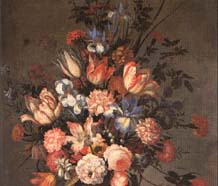
Balthasar van der Ast
There were also emblems and hidden religious and political symbols in these paintings. Moreover, there was a religious fracture between Catholics and Protestants, between the South and the North which induced many painters to become more allusive in their works. In addition, these paintings contained hidden proverbs or were destined to certain circles.
Fish still-lives were mainly produced in the Hague which had an important market, breakfast still-lives were a speciality in Haarlem while flowers were more in demand in Utrecht. Nevertheless, these paintings also reflected a change in mentality and thinking.
Deep economic changes occurred at the end of the 16th Century in Holland and the Flanders which were under the rule of the Habsburg dynasty. With the development of overseas trade, traditional agriculture receded while the development of markets became spectacular.
Dutch and Flemish people became more accustomed to buying fruits and other foods and because of the new opulence, painters had a new approach towards their fetichism. Religious symbols thus became less important while wealth became the target of hidden criticisms.
In Holland notably, the trend was to oppose the traders and the peasants, the former representing economic prosperity and the latter the old world. Still, religious meanings kept being underlined such as in the representation of meat which could indicate a threat to faith, weak flesh or the ritual sacrifice of an animal.
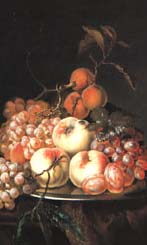
Herman van der Myn
Kitchen scenes had also several meanings relating to the Last Supper, wealth, waste or eroticism depending on the representation of objects, food and servants.
The new opulence multiplied all kinds of desires which were also represented in such paintings. They sometime reflected avidity, concupiscence, pleasure, love, luxury, vice, vanity, laziness, sight, touch, smell, hearing and so on.
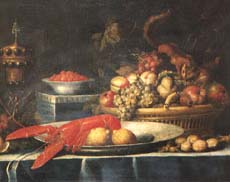
Attributed to Gerrit Willemsz. Horst
|


|
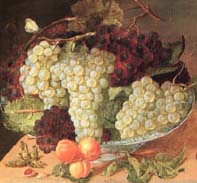
Isaac Soreau
Still-lives paintings became much popular throughout continental Europe during the 17th Century as they represented beauty and religious symbols altogether, meaning that their owners could admire and interpret them at the same time.
The term "still-life" only appeared during the middle of the 17th Century. Before 1650, people spoke of fruit, banquet or luncheon paintings. This works were much appreciated when one knows that the Dutch artist Ambrosius Bosschaert received 1000 guilders for a painting of flowers whereas the price of a portrait in Holland around 1625 was fixed at about 60 guilders. The story of still-life painting started in fact in Ancient Greece when Zeuxis painted raisins which were so realistically reproduced that birds would try to pilfer them.
The art of creating illusion was also much admired during the 14th Century, notably in Italy where several mural deception paintings were produced and during the 15th Century when Flemish masters Jan van Eyck or Robert Campin introduced still-lives in their paintings. However, still-life painting began in earnest at the start of the 16th Century.
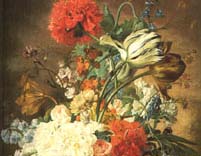
Wybrand Hendriks |
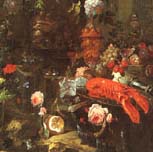
Jacob Caproens |
From then on, the representation of flowers, dead animals or objects became more symbolic as each thing had a religious meaning according to the Bible. For example, still-lifes with raisins, apples or pears represented the blood of Christ, his love for the Church or the softnes of his transformation into Man while a lobster represented his resurrection.

Balthasar van der Ast
There were also emblems and hidden religious and political symbols in these paintings. Moreover, there was a religious fracture between Catholics and Protestants, between the South and the North which induced many painters to become more allusive in their works. In addition, these paintings contained hidden proverbs or were destined to certain circles.
Fish still-lives were mainly produced in the Hague which had an important market, breakfast still-lives were a speciality in Haarlem while flowers were more in demand in Utrecht. Nevertheless, these paintings also reflected a change in mentality and thinking.
Deep economic changes occurred at the end of the 16th Century in Holland and the Flanders which were under the rule of the Habsburg dynasty. With the development of overseas trade, traditional agriculture receded while the development of markets became spectacular.
Dutch and Flemish people became more accustomed to buying fruits and other foods and because of the new opulence, painters had a new approach towards their fetichism. Religious symbols thus became less important while wealth became the target of hidden criticisms.
In Holland notably, the trend was to oppose the traders and the peasants, the former representing economic prosperity and the latter the old world. Still, religious meanings kept being underlined such as in the representation of meat which could indicate a threat to faith, weak flesh or the ritual sacrifice of an animal.

Herman van der Myn
Kitchen scenes had also several meanings relating to the Last Supper, wealth, waste or eroticism depending on the representation of objects, food and servants.
The new opulence multiplied all kinds of desires which were also represented in such paintings. They sometime reflected avidity, concupiscence, pleasure, love, luxury, vice, vanity, laziness, sight, touch, smell, hearing and so on.

Attributed to Gerrit Willemsz. Horst
The representation of skulls in many paintings meant the shortness of life and the futility of wealth.
Oysters often represented vaginas while sugar meant spiritual good but also lust. Therefore, dozens of objects, fruits, flowers, insects, animals and other things had always a particular significance in these paintings.
They carried many stories and legends, religious, political, philosophical apart from being decorative and played a major part in the life of many people during the 17th and 18th Century. They also served to demonstrate the great skills of many painters such as
David Bailly (1584-1657), Balthasar Van der Ast (1593-1657), Abraham Van Beijeren (1620-1690), Pieter Aertsen (1508- 1575), Willem Van Aelst (1627-1683), Ambrosius Bosschaert (1573-1621), Pieter Claesz (1597-1660), Adriaen Coorte (17th Century), Jacob Gerritsz Cuyp (1594-1651), Floris Van Dyck ( 1575-1651), Cornelius Jacobsz Delft (1571-1643), Franchoys Elout (1597-1641 ?), Carel Fabritius (1622-1654), Pieter de Putter (1600 ?-1659), Willem Claesz Heda (1594-1680), Jan Davidsz de Heem (1606-1654), Maerten van Heemskerck (1498-1574), Samuel Van Hoogstraten (1627-1678), Jacques Grief called de Claeuw (?-After 1676), Jan Van Huysum (1682-1749), Willem Kalf (1619-1693), Otto Marseus Van Schrieck (1619-1678), Willem de Poorter (1608-1650 ?), Jan Vermeulen (1638-1674), Johannes Leemans (1633 ?-1687), Hendrick Pot (1585-1657), Rembrandt Harmensz Van Rijn (1606-1669), Pieter de Ring (1615-1660), Piter Cornelisz Van Ryck (1568-1628 ?), Rachel Ruysch (1664-1750), Jan Saenredam (1565-1607), Adriaen Van der Spelt (1630-1673), Matthys Bloem (17th Century), Theodor Van Thulden (1606-1669), Jan Vermeer of Delft (1632-1675), Jan Weenix (1640-1719), Jan Baptist Weenix (1621-1663) and Joachim Antonisz Wtewael (1566-1638)
all from Holland, Francisco Zurbarran (1598-1664), Diego de Silva y Velazquez (1599-1660), Fray Juan de Sanchez-Cotàn (1561-1627), Tomas de Yepes (?-1674), Mateo Cerezo (1637-1666), Antonio de Pereda (1608 ?-1678)
from Spain, Giuseppe Arcimboldo (1527 ?-1593), Jacopo de Barbari (1440-1515 ?), Evaristo Baschenis (1617-1677), Vincenzo Campi (1536-1591), Michelangelo Merisi da Carravaggio ( 1571-1610), Annibale Caracci (1560-1609), Antonio Mara called Scarpetta (1680 ?-1750 ?), Taddeo Gaddi (1300-1366), Giotto di Bondone (1266-1337), Pietro-Paolo Bonzi (1563 ?-1644 ?), Elisabetta Marchioni (18th Century), Carlo Magini (1720-1806), Giacomo Ceruti called il Pitochetto (1724 ?- ?), Leonardo da Vinci (1452-1519), Francesco di Giorgio Martini (1439-1502) and Bartolommeo Passarotti (1529-1592), Giacomo Recco (1603-1653)
from Italy, David Teniers the Younger (1610-1690), Frans Snyders (1579-1657), Daniel Seghers (1590-1661), Peter Boucle (1610 ?-1673), Peter Casteels (1684-1749), Peter Paul Rubens (1577-1640), Clara Peeters (1594- ?), Adriaen Van Nieulandt (1587-1658), Frans Ykens (1601-1693), Jan-Pauwel Guillemans the Younger (1651-1704), Jan Baptist Bosschaert (1667-1746), Hans Memling (1430 ?-1494), Quentin Massys (1465 ?-1530), Jan Van Kessel (1626-1679), Jacob Jordaens (1593-1678), Georg Hoefnagel (1542-1600), Jan Gossaert called Mabuse (1470-1532), Hugo Van der Goes (1440 ?-1482), Cornelius Norbertus Gijsbrechts (17th Century), David de Coninck (1636-1699), Jan Fyt (1611-1661), Frans Francken II (1581-1642), Louis Finson (1578-1631), Jan Brueghel the Elder (1568-1625), Pieter Boel (1622-1674), Joachim Beuckelaer (1530-1573), Osias Beert (1580-1624), Andries Danielsz (Early 17th Century), Karl Wilhelm de Hamilton (1668-1754), Jacob Van Hulsdonck (1582-1642), and Hendrick Van Balen (1575-1632)
all Flemish, Lubin Baugin (1610-1663), Pierre-Nicolas Huilliot (1674-1751), Jacques Linard (1600-1645), Louise Moillon (1615-1674), Jean-Michel Picart (1600-1682), Nicolas de Largillière (1656-1746), Sébastien Stosskopf ( 1597-1657), Jean-Jacques Prévost (1735-1760), Jean-Baptiste Monnoyer (1634-1699) and Jean-Baptiste Siméon Chardin (1699-1779)
from France, Johan Georg Hinz (17th Century), Ernst Stuven (1660-1712), Johann Andreas Herrlein (1720-1796), Hans Holbein the Younger (1497 ?-1543) and Georg Flegel (1566-1638), Albrecht Dürer
(1471-1528) from Germany.
This list is far from being complete.
|
|
|
|